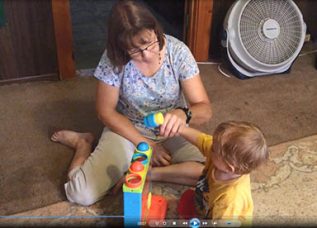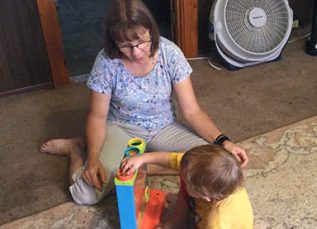
Module 6: Specific Teaching Strategies
Upon Completing this module you will understand:
- The basis for using the ABC format

- Prompting strategies
- The one-up rule
Activities to support your learning:
- Read pages 21-22 and 262-263.
- Review Handout: The ABCs of ESDM
- Read/review: Types of Prompts
- Read pages 176-178
- Read/Review the following information:
The ABCs of ESDM
- Read: The ABCs of ESDM
- Watch: ABCs and Prompting video
Language
(Read pages 176-178)
- One-up rule: Use language that is one step beyond the child’s current language level.
- If child is non-verbal use single words.
- If child uses single words, use 2 word phrases.
- If the child uses echolalia, apply the one-up rule to spontaneous speech only, not echoed phrases.
- Narrate, narrate, narrate! Use a rich variety of vocabulary including verbs and adjectives.
- Recast, restate, and expand. Repeat back child’s utterances with correct syntax and articulation.
Prompting
Prompting is a teaching strategy used to help a child acquire new skills. A prompt is a cue or an action to assist or encourage a desired response.
There are different types of prompts that vary in intrusiveness, from least to most. In general, you should use the least to most intrusive prompt needed to teach a new skill. This promotes independence and reduces the risk of the child becoming prompt dependent. We should always start with the end in mind to prevent the child from becoming prompt-dependent.
Read Types of Prompts and view Decreased Prompting Video
Types of Prompts
Indirect Verbal: A question that provides a cue or hint about what the child should do.
Direct Verbal: A specific verbal instruction.
Gesture: A motion such as pointing, tapping, or glancing in the direction of the desired item, location, or activity.
Model: A demonstration of the task you want the child to do.
Partial Physical: Minimal guidance is provided to help the child complete a task.
Full Physical: Gentle physical support is provided to support the child in completing the task.
Fading Prompts
Since the goal is for the child to become increasingly independent, prompts will be faded over time. Prompts are faded by waiting before using a prompt or by moving from a more intrusive prompt such as a full physical prompt to a less intrusive partial physical prompt, then to a model prompt and so on.
Shaping
Shaping is another teaching strategy to support children’s acquisition of new skills. By reinforcing behaviors that are similar to the target skill or behavior, we move the child closer to the target outcome or objective.
- Be specific when defining the target behavior
- Reinforce approximations
- Emphasize independence over accuracy – reinforce approximations and shape into more mature behaviors over time. Small steps toward the ultimate goal are cause for celebration!
Module 6 Reflection: What have I learned?
Describe your understanding and knowledge of the following:
- What is ABC format?
- Why is the ABC format used in ESDM?
- How was the ABC format used in the ABCs and Prompting video clip
- What prompting strategies are used in ESDM?
- What does least-to-most prompting look like?
- What prompting did you see in the Decreased Prompting video?
- What is meant by the one-up rule?
- What is the rationale for using the one-up rule?
- I would like more information about ….
Try this!
Choose a typical infant/toddler toy or activity that you currently use in your practice. With this toy or activity in mind think about the 4-steps of teaching and consider these questions:
- How many ways can you find to use this object or activity to teach the selected objective?
- What language (words/sounds) can you model during the activity?
- What other ways can you use the object or activity to elaborate and expand on the play?


